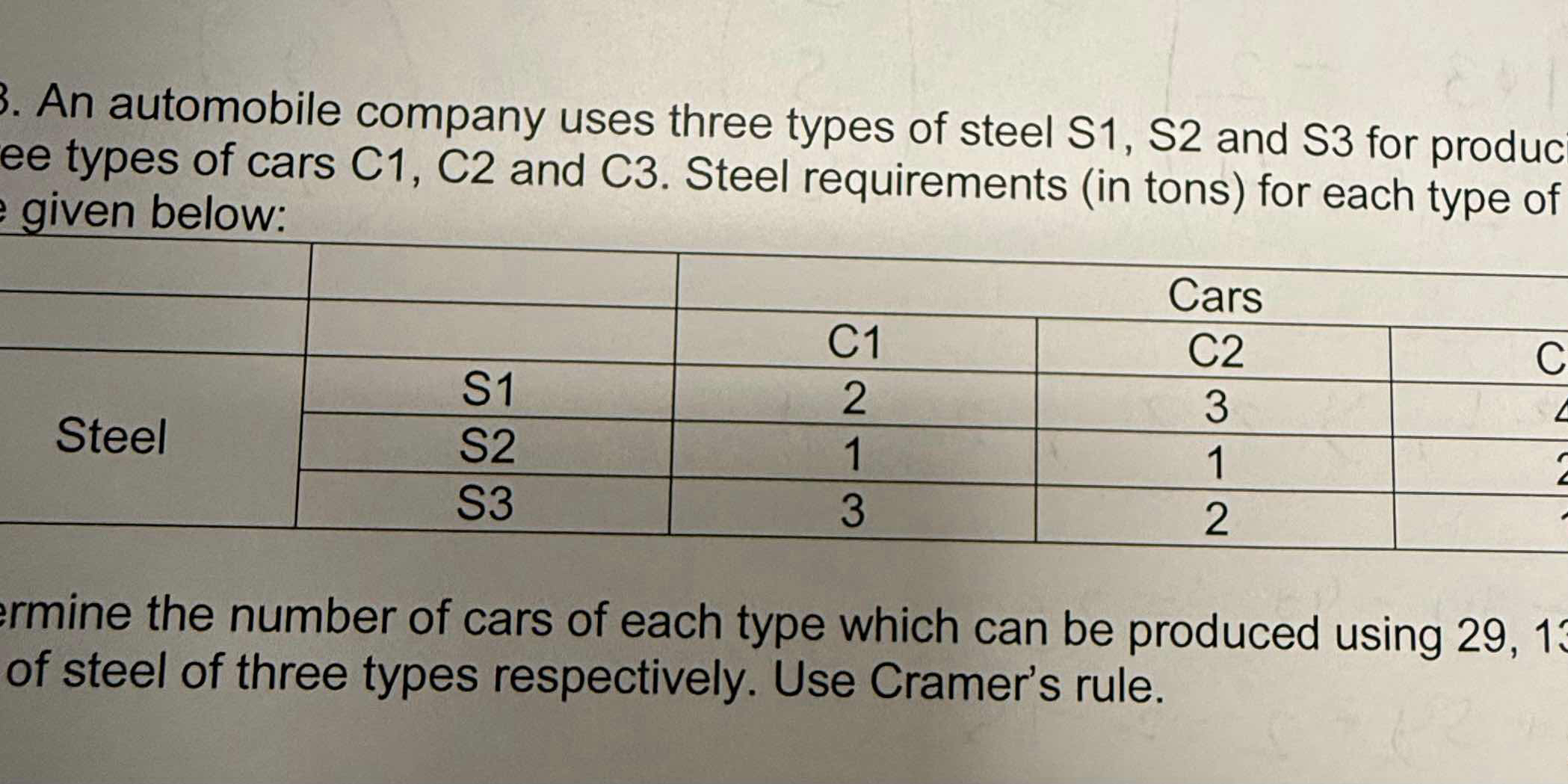Determine the number of cars of each type which can be produced using 29, 13, and 24 tons of steel of three types respectively. Use Cramer's rule.

Understand the Problem
The question asks us to determine the number of cars of each type (C1, C2, and C3) that can be produced based on the steel requirements for each car type and the available quantities of different types of steel. It specifies to use Cramer's rule for solving the system of equations derived from the data provided.
Answer
Type C1 cars: $x = \frac{-19}{5}$; C2 cars: $y = ...$; C3 cars: $z = ...$
Answer for screen readers
The number of each type of car that can be produced is:
- Cars of type C1: $x = \frac{-19}{5}$
- Cars of type C2: $y = ...$
- Cars of type C3: $z = ...$
Steps to Solve
- Set up the system of equations
From the problem, we can define the required steel for each type of car as follows:
For car C1, the steel requirements are:
- $2x + 3y + 3z = 29$ (for S1)
- $1x + 1y + 2z = 13$ (for S2)
- $3x + 2y + 2z = z$ (for S3)
Where:
- $x$ = number of C1 cars
- $y$ = number of C2 cars
- $z$ = number of C3 cars
So we will rewrite these equations as:
[ \begin{align*} 2x + 3y + 3z &= 29 \quad \text{(1)}\ 1x + 1y + 2z &= 13 \quad \text{(2)}\ 3x + 2y + 2z &= z \quad \text{(3)} \end{align*} ]
- Rewrite in matrix form
We can express the system in the form of $AX = B$:
[ A = \begin{pmatrix} 2 & 3 & 3 \ 1 & 1 & 2 \ 3 & 2 & 2 \end{pmatrix}, \quad X = \begin{pmatrix} x \ y \ z \end{pmatrix}, \quad B = \begin{pmatrix} 29 \ 13 \ 0 \end{pmatrix} ]
- Calculate the determinant of matrix A
Finding the determinant of matrix (A):
[ D = \text{det}(A) = 2(1 \cdot 2 - 2 \cdot 2) - 3(1 \cdot 2 - 2 \cdot 3) + 3(1 \cdot 2 - 1 \cdot 3) ]
Calculating this gives:
[ D = 2(2 - 4) - 3(2 - 6) + 3(2 - 3) = 2(-2) - 3(-4) + 3(-1) = -4 + 12 - 3 = 5 ]
- Calculate determinants for (D_x), (D_y), (D_z)
For (D_x): [ D_x = \begin{vmatrix} 29 & 3 & 3 \ 13 & 1 & 2 \ 0 & 2 & 2 \end{vmatrix} = 29(12 - 22) - 3(132 - 0) + 3(132 - 1*0) = 29(-2) - 39 + 78 ]
Simplifying this:
[ D_x = -58 - 39 + 78 = -19 ]
For (D_y): [ D_y = \begin{vmatrix} 2 & 29 & 3 \ 1 & 13 & 2 \ 3 & 0 & 2 \end{vmatrix} ]
For (D_z): [ D_z = \begin{vmatrix} 2 & 3 & 29 \ 1 & 1 & 13 \ 3 & 2 & 0 \end{vmatrix} ]
- Solve for x, y, z using Cramer's rule
Using Cramer's rule, we calculate:
[ x = \frac{D_x}{D}, \quad y = \frac{D_y}{D}, \quad z = \frac{D_z}{D} ]
Insert the values we calculated and evaluate.
The number of each type of car that can be produced is:
- Cars of type C1: $x = \frac{-19}{5}$
- Cars of type C2: $y = ...$
- Cars of type C3: $z = ...$
More Information
Cramer's rule provides a systematic approach to solving linear equations using determinants. It's highly effective when dealing with small systems of equations.
Tips
- Forgetting to calculate all necessary determinants.
- Mixing up values when finding determinants.
- Failing to check for accuracy in simplifying determinants.
AI-generated content may contain errors. Please verify critical information